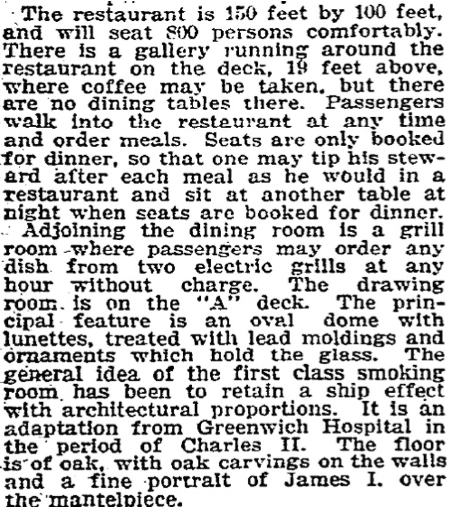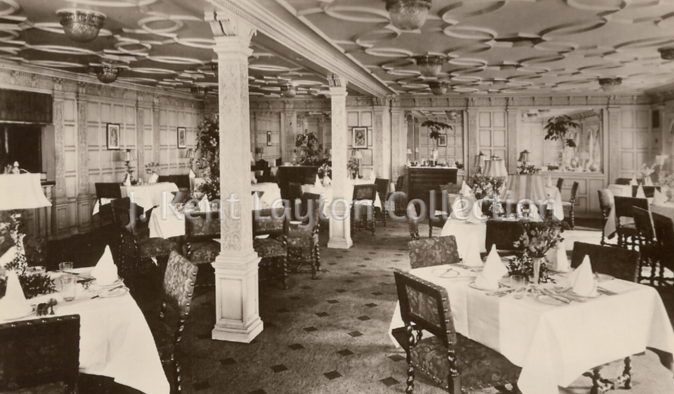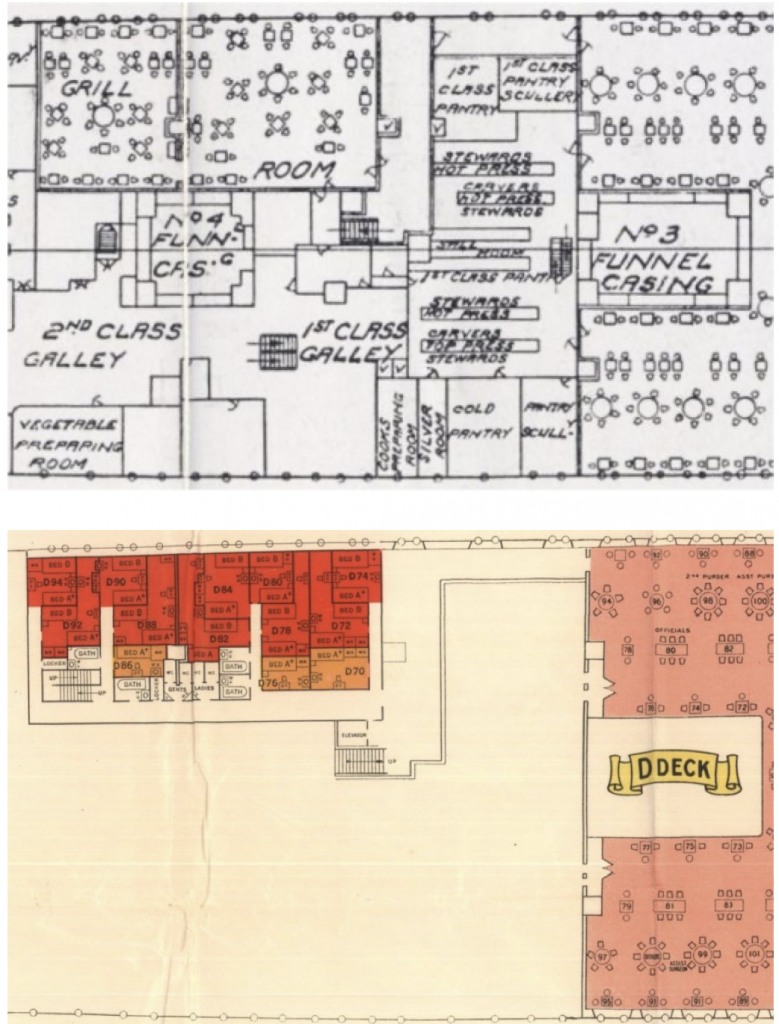FAQ: Aquitania‘s First Class Grill Room
Was Aquitania’s First Class Grill Room An a la carte Restaurant?
No.
Contrary to popular belief, Aquitania did not have an a la carte restaurant. Cunard’s attitude towards an extra-tariff facility of this sort was different to HAPAG’s or the White Star Line.
When Olympic entered service in 1911, she proved very popular with first class passengers. Her a la carte restaurant was so popular that additional tables were soon ordered, and it was enlarged during the ship’s 1912-13 refit. It was also a revenue earner for the White Star Line because passengers who used the restaurant paid extra to enjoy its facilities. The benefit of the restaurant was that a first class passenger could choose to eat when they wanted, rather than being limited by the sitting times in the main first class dining saloon. They also had a wider choice of dishes, which was equal to the finest restaurants and hotels ashore. One observer thought that the restaurant’s décor made it one of the nicest public rooms on the ship.
However, Cunard’s naval architect, Leonard Peskett, felt that the restaurant created ‘a new class of passenger’ within first class – people who stood aloof from other first class diners. This attitude continued into the post-war years. When the German liner Imperator joined Cunard’s fleet and was renamed Berengaria, her a la carte restaurant was removed and instead the room served as a ballroom; after the Cunard White Star merger in 1934, the a la carte restaurants onboard both Olympic and Majestic were closed down before the year’s end. (The galley equipment from Majestic’s restaurant was removed early in 1935.)
Aquitania’s arrangement was unique. The main first class dining saloon was designated as a ‘restaurant.’ However, an additional first class grill room was also provided aft of the dining saloon – on the port side. This room is often mistaken for an a la carte restaurant. The New York Times reviewed Aquitania’s first class accommodation when she arrived in New York on her maiden voyage in 1914, writing:

When Aquitania made her maiden eastbound crossing in June 1914, some difficulties arose due to the large number of first class passengers. One Cunard memo. noted:
Owing to the dining room now being called [a] restaurant, and it being advertised in New York that a la carte meals would be served, without charge, full advantage has been taken by the passengers. It has been one continuous meal, and I am afraid large numbers of crew will not sign on again.
…I would suggest that a notice be printed on the breakfast menu that no a la carte orders for luncheon can be taken after 10 o’clock, and on the luncheon menu that no a la carte dinner orders can be taken after 2 p.m. The menus are all of good variety, and to relieve the great pressure at luncheon, I put each day two dishes extra, marked as ‘special dishes’ and it met with a great success.
John Maxtone-Graham’s fine book, Crossing & Cruising, examines the grill room in detail.

Above: Aquitania‘s first class grill room, pictured in the 1920s. The decor had much in common with Olympic‘s first class dining saloon – so much so, that Cunard altered the original design slightly in July 1913, because they thought it looked too similar. (J. Kent Layton collection)
Why was Aquitania‘s First Class Grill Room removed?
Below: Aquitania‘s first class grill room when she entered service and the same area after it was removed and converted to passenger staterooms in 1936. (The Shipbuilder, 1914/Author’s collection; and Aquitania Cruise Plan, 1938/Author’s collection.)

By 1935, the first class grill room was not as popular as it had been. First class passenger lists were not as high as they had been during Aquitania’s heyday. At a Cunard White Star executive committee meeting in early September 1935, some defects were noted:
…very shabby appearance of the Ruboleum tiling in the grill room of the Aquitania, also in the corridor leading to that room. Renewal of this tiling was included in the schedule submitted for the vessel’s overhaul last winter but was deferred.
Removal and re-laying the tiling would cost approximately £335, but in view of the fact that the grill room is not very extensively used, it has been submitted that the deck be covered with carpet ex Olympic restaurant which is in quite good condition.
During a meeting in September 1936, Cunard’s Board decided that they needed to increase Aquitania’s tourist class passenger capacity to meet an anticipated increase in tourist class passengers in 1937 and beyond. Since the grill room was ‘not very extensively used,’ they chose to remove it:
It has been found possible, by converting the existing grill room on D-deck into passenger space, to provide for 44 passengers [sic]. The cost of the work is estimated at £7,000, and the passenger department is satisfied that this increase in the vessel’s earning capacity would produce £18,000 in the first year.
Although Aquitania’s first class (renamed ‘cabin’) passenger lists recovered in the late 1930s, they did not regain their pre-1931 level. In 1937, her highest cabin passenger lists were 436 westbound and 413 eastbound – less than her averages in the 1920s. They were easily accommodated in the main first class restaurant. In tourist class, Aquitania had a slightly better year in 1937, with her best performance for five years. Third class numbers rose very sharply, to their best since 1924.
